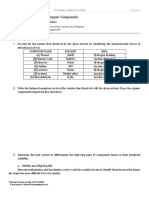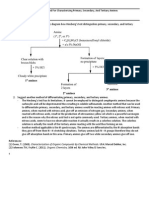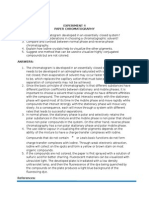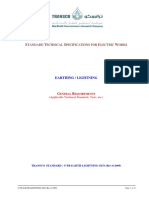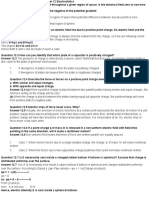Chem 31.1 Formal Report Expt 16
Chem 31.1 Formal Report Expt 16
Uploaded by
Angelo VillaranteCopyright:
Available Formats
Chem 31.1 Formal Report Expt 16
Chem 31.1 Formal Report Expt 16
Uploaded by
Angelo VillaranteOriginal Description:
Copyright
Available Formats
Share this document
Did you find this document useful?
Is this content inappropriate?
Copyright:
Available Formats
Chem 31.1 Formal Report Expt 16
Chem 31.1 Formal Report Expt 16
Uploaded by
Angelo VillaranteCopyright:
Available Formats
Synthesis of 1-phenylazo-2-naphthol
[1]
Busog, Bea and [2]Villarante, Angelo Ismael M.
[1]
Institute of Biology, College of Science, University of the Philippines, Diliman, Quezon City
[2]
Department of Food Science and Nutrition, College of Home Economics, University of the
Philippines, Diliman, Quezon City
Date Performed: October 30, 2014 November 04, 2014
Date Submitted: November 13, 2014
Abstract
Azo compounds are known for their functions as dyes and coloring reagents.
Formation of 1-phenylazo-2-naphthol, consists of two reactions: diazotization reactions and
coupling reactions. In diazotization reactions, a diazonium salt is formed from aniline and nitrous
acid (NaNO2 + HCl). While in coupling reactions, positively charged diazonium serves as the
electrophile to the -naphthol to give the coupling product. The experiment yielded 24.07% of
the 0.54 g theoretically calculated result. And a 4.48%-11.19% %error range was calculated for
the melting point determination. Possible errors are formation of side products and improper
preparation of reagents.
I. Introduction
Two reactions comprise the synthesis of 1phenylazo-2-naphthol. The first of these
reactions is called diazotization. This reaction
forms one of the most versatile intermediate in
organic synthesis, the diazonium salt. The
intermediate is formed from the reaction of
primary aromatic amines and nitrous acid.
Figure 1.Diazotization reaction
Diazo-compounds are the products formed
from the coupling reaction, the second and last
reaction of the synthesis, wherein the
positively charged aryl diazonium ion serves as
the electrophile towards the highly activated
aromatic substrates such as phenols and
anilines. Most of these diazo-compounds are
used as acid-base indicators like methyl orange
and methyl red and as food coloring agents
such as butter yellow but some are used as
staining agents and as textile dyes for fabric.
Figure 2.Coupling reaction
Textile dyes absorb light in the visible region
through
the
functional
group
called
augmenters
called
auxochromes.
These
includes the types NHR, -NR2, -OH, and OR.
The simple azo dyes that were synthesized in
1-phenylazo-2-naphthol are capable of dyeing
cotton as a developed or ingrain dye.
Dyes that adhere firmly to the fibers without
the aid of supplemental chemicals are within
the method of direct dyeing. These fibers, like
silk and wood, have many polar sites that bind
strongly to the polar dyes such as malachite
green, and methyl orange. In ingrain dyeing on
the other hand, fiber such as those in cotton is
impregnated with an amine, which is then
diazotized and then developed by immersion in
a phenol solution.
The method of dyeing used is such that the dye
is
synthesized
inside
the
fabric.
Two
components used in its synthesis will diffuse
into the spaces between the fibers inside the
fabric. Here, the component reacts within it
forming the azo dye. In this experiment, Sudan
1 will be synthesized through diazotization and
coupling reactions, its property as an ingrain
dye also examined. (Organic Chemistry Manual
2014.)
Levelness refers to how evenly distributed the
dye is throughout the substrate. It relies on the
use of the correct procedure based on the
substrate and the agitation provided by the
machinery being used. It is also derived from
level initial padding of dye for a continuous
dyeing. The resistance of a dye to removal or
chromophores, the color bearers. The
extended conjugation of the two aromatic
rings, the N=N- in azo dyes, causes the light
to
be
absorbed.
Aside
from
these
chromophores, textile dyes also contain color
fabric, thus making it have a few darkly stained
lines and blotches.
In the synthesis of Sudan-1, two-pot synthesis
was used. Two-pot synthesis is appropriate
because it incorporates faster separation
process and more efficient purification (Reusch,
2013).
II. Methodology
In the phenyldiazonium chloride solution, 0.2
mL aniline, 0.35 mL water, and 0.5 mL conc.
HCl were added in a 50-mL Erlenmeyer flask.
The mixture was cooled to 4C, after which 1
mL ice-cold distilled water was added. A
spatula-full NaNO2 crystal was added to the
resulting cold mixture, and maintained its
temperature at below 5C.
destruction is fastness. It is achieved mainly on
the selection of dyes. It also depends on the
removal of hydrolyzed reactive dye.
The synthesized dye that we had made
efficiently passed fastness since the red-orange
dye did not wash out after several washes with
water. In terms of levelness though, our dye
was not evenly distributed all throughout the
Figure 3. Diazotization of aniline with HCl and
NaNO2
Next, the diazonium ion was reacted with
prepared -naphthol solution. This is the
coupling reaction. The -naphthol couples with
the diazonium salt forming a resonance
stabilized intermediate. The figure below shows
the reaction.
-naphthol solution was prepared by dissolving
0.35 g -naphthol in 4.5 mL 5% NaOH (aq) in a
50-mL beaker, was cooled to 4C.
Prior to synthesis, dyeing was done. A fabric
was dyed in the -naphthol solution. After
soaking for 2-3 minutes, the fabric was
removed and pat dried. After which the fabric
was immersed in the phenyldiazonium chloride
solution, then rinsed with running water.
The remaining phenyldiazonium chloride
solution was added to the cold -naphthol
solution. The mixture was allowed to stand at
4C for 1-5 minutes. Filtering was done to the
product, as well as washing with portions of
cold water. Recrystallization was done using
minimal hot ethanol. After which weight
determination was done for the % yield, and
melting
point
determination
was
done
afterwards.
III. Results and Discussion
The
synthesis
of
1-phenylazo-2-naphthol
consists of two reactions, forming of the
diazonium salt intermediate and coupling
reactions. The formation of the diazonium salt
intermediate, or diazotization, was formed by
reacting aniline with HCl and NaNO 2. The
diazotization process starts when a proton and
N is exchanged, from which the Nitrogen lone
Figure 4. Coupling reaction of diazonium salt
with -naphthol.
pairs form triple bonds of N from NaNO 2 (DeTar
et al, 1955). The figure below shows the
detailed reaction mechanism.
Figure 5. Diazonium ion resonance forms.
From the figure above, delocalization of ions
causes the salt to be a weak electrophile. Thus
it would only react with strongly activated
compounds, in this case naphthol, having OH
as the strong activator (as seen from the
intermediate). The diazonium salt attacks the
carbons at para- and ortho- positions with
respect to activating substituent of benzene
(McMurry, 2012). Carbon 1 was
attacked because the OH is in the para- and
ortho- positions. However, the para- position is
unstable due to unavailability of Hydrogen for
substitution, thus the product is formed by the
ortho- position.
Throughout the reaction process, the reaction
mixtures temperature was maintained at
below 5C to prevent decomposition. When
done at higher temperatures a possible side
reaction may occur. -naphthol was prepared
under basic conditions because as a phenol, it
reacts readily at weakly basic conditions. If it
was prepared under acidic conditions, the naphthol will be protonated to form a salt, as
explained on the Chemistry Department of the
Northern Virginia Community College. As
explained on Chemistry Section of the National
Programme on Technology Enhanced Learning,
if the phenyldiazonium chloride was done in a
basic medium, the diazonium salt is reduced to
an aryl radical, which reacts with the benzene
ring. The figure below shows the reaction under
basic conditions.
Figure 6. Diazotization under basic conditions.
Afterwards, ingrain dyeing was done. After the
fabric was soaked in the -naphthol solution
and pat dried, the fabric was immersed in the
phenyldiazonium
chloride
solution.
Upon
immersion, the fabrics color turned to orange.
This indicated the synthesis of desired azo dye.
When the fabric was washed, the color was not
washed off, indicating the dye was trapped
between the fibers of the fabric. Cotton lacks in
strong polarized groups, thus it cannot produce
strong interactions with anions or cations
(Department
of
Textile
and
Apparel
Figure 7. Sudan-1
The table below shows Experimental Results
and Melting Point Determination (See Data
Sheet for Calculations).
Table 1. Experimental Results
1-phenylazo-2naphthol, g
Theoretical Yield
%yield
0.13 g
0.54g
24.07%
Table 2. Melting Point Determination
Experimental Melting
115%-120%
Point, C
Theoretical Melting
134%
Point, C
%error
4.48%-11.9%
In the experiment, we were able to obtain the
melting point of the pure Sudan 1 within the
range of 115-120oC and the crude, ranging
from 119-140oC as oppose to the theoretical
melting point of 134o C. The purity of the
synthesized dye that we obtained theoretically
was accurate and close enough to the
theoretical yield. Using the crude melting point
range, the percent error ranges from 4.48% to
11.19%.
The percent yield we had obtained in the
experiment was unexpectedly low, having it at
only 24.07% with an actual yield of 0.13 grams
and a theoretical yield of 0.54 grams. Possible
sources of error in the experiment could come
from the preparation of the reagents used
Management, University of Missouri, 2008).
From the aforementioned statement, cotton
cannot produce interactions with 1-phenylazo2-naphthol. By using ingrain dyeing instead of
direct dyeing, 1-phenylazo-2-naphthol (an azo
dye) with big molecules can permanently
diffuse the color into the fibers.
itself, the purity of it, or in the preparation of
the 1-phenylazo-2-naphthol. Another thing to
be taken into account would be the formation
of side products that may have formed during
the reactions in the experiment. These side
products are the result of not being able to
prevent keeping the temperature at 4oC.
The red-colored appearance of Sudan 1 with
the
structure
below
is
because
of
delocalization. The light is absorbed in the
visible region once it has synthesized in the
fabric through the functional group called
chromatophore and color deepeners called
auxochromes (Department of Chemistry,
University of Washington).
IV. Conclusion
The experiment was successful in synthesizing
Sudan-1 from the diazotization of aniline.
However, only 0.13 grams of Sudan-1 was
recovered, which yielded a 24.07% from the
0.54 grams of the calculated theoretical yield.
The calculated results could have deviated
from the aforementioned discrepancies in the
previous paragraph.
V. References
[1] McMurry, J. Organic Chemistry. Belmont,
California: Brooks/Cole CENGAGE Learning,
2012.
[2] DeTar, D.F and Turetzky, M.N. 1955. The
Mechanisms of Diazonium Salt Reactions.
Journal of the American Chemical Society.,
77(7), p1745-p1750.
[3] Reusch, W. 2013. Reaction of Amines.
Department of Chemistry, Michigan State
University. < http://www.chemistry.msu.edu/ >
Acessed on November 10, 2014.
[4] Chemistry Section, National Programme on
Technology
Enhanced
Learning.
<
http://nptel.ac.in/ > Accessed on November 11,
2014
[5] Synthesis of an Azo Dye. Department of
Chemistry, University of Washington. <
http://depts.washington.edu/ > Accessed on
November 11, 2014.
[6] Department of Chemistry, North Virginia
Community
College.
<
http://www.nvcc.edu/index.html > Accessed on
November 12, 2014.
[7] Project Cotton. 2008. Department of Textile
and Apparel Management, University of
Missouri. <
http://cotton.missouri.edu/ > Accessed on
November 12, 2014.
[8] Organic Chemistry Laboratory Manual.
Organic Chemistry Academic Group, Institute of
Chemistry. University of the Philippines
Diliman, Quezon City.
You might also like
- Chem 31.1 Finals NotesDocument25 pagesChem 31.1 Finals NotesElah Palaganas100% (1)
- Synthesis of 1-Phenylazo-2-Naphthol or Sudan-1Document3 pagesSynthesis of 1-Phenylazo-2-Naphthol or Sudan-1Ruther Cabral100% (9)
- CEIC2000 Exam 2016 MainDocument18 pagesCEIC2000 Exam 2016 MainMeena LochniNo ratings yet
- Carding (Jute)Document12 pagesCarding (Jute)ইসলামিক টিভি80% (5)
- Experiment 9 Relative Rates of Electrophilic Aromatic Substitution QuestionsDocument1 pageExperiment 9 Relative Rates of Electrophilic Aromatic Substitution QuestionsElah PalaganasNo ratings yet
- Chem 31.1 ATQ 2Document2 pagesChem 31.1 ATQ 2Mikaela BiolenaNo ratings yet
- Chem 31.1 Unknown Analysis Cheat SheetDocument2 pagesChem 31.1 Unknown Analysis Cheat Sheetฝน เมนโดซาNo ratings yet
- Chem 31.1 ATQ 1 - FinalDocument2 pagesChem 31.1 ATQ 1 - FinalMikaela BiolenaNo ratings yet
- Synthesis and Purification of Tert-Butyl Chloride Chem 31.1Document4 pagesSynthesis and Purification of Tert-Butyl Chloride Chem 31.1John Christian LopezNo ratings yet
- Solubility of Organic Compounds: Answers To QuestionsDocument3 pagesSolubility of Organic Compounds: Answers To QuestionsMatthew Rei De LeonNo ratings yet
- Chem31.1 ATQ12 Santos PDFDocument3 pagesChem31.1 ATQ12 Santos PDFClaire SantosNo ratings yet
- Synthesis of 1 Phenylazo 2 NaphtholDocument4 pagesSynthesis of 1 Phenylazo 2 NaphtholDaphne MercadoNo ratings yet
- Synthesis of 1-Phenylazo-2-Naphthol FRDocument4 pagesSynthesis of 1-Phenylazo-2-Naphthol FRChino BandonilNo ratings yet
- Last FR Chem 31Document4 pagesLast FR Chem 31James Soriano100% (1)
- Department of Mining, Metallurgical and Materials Engineering, University of The Philippines, Diliman, Quezon CityDocument4 pagesDepartment of Mining, Metallurgical and Materials Engineering, University of The Philippines, Diliman, Quezon CityRochelle ManchamNo ratings yet
- Synthesis of 1-Phenylazo 'Sudan 1'Document5 pagesSynthesis of 1-Phenylazo 'Sudan 1'seryuyuyu100% (2)
- Postalb 16-Synthesis of Sudan 1Document2 pagesPostalb 16-Synthesis of Sudan 1edcalumpitNo ratings yet
- Chem 31.1 - FR2 CastroDocument4 pagesChem 31.1 - FR2 CastroMatthew Rei De LeonNo ratings yet
- Synthesis of 1-Phenylazo-2-NaphtholDocument6 pagesSynthesis of 1-Phenylazo-2-NaphtholdatUPstudentdoeNo ratings yet
- Fr3 Synthesis of 1 Phenylazo 2 NaphtholDocument4 pagesFr3 Synthesis of 1 Phenylazo 2 NaphtholRon Andrei Soriano0% (1)
- Exp 16-FR 3 SudanDocument14 pagesExp 16-FR 3 Sudanherbie_wanNo ratings yet
- Synthesis of 1 Phenylazo 2 NaphtholDocument8 pagesSynthesis of 1 Phenylazo 2 NaphtholChris Zayn0% (1)
- Synthesis of 1 Phenylazo 2 Naphthol RDRDocument2 pagesSynthesis of 1 Phenylazo 2 Naphthol RDRNashDanielSilavaNo ratings yet
- Aldehydes and Ketones: Answers To QuestionsDocument2 pagesAldehydes and Ketones: Answers To QuestionsGaby de GuzmanNo ratings yet
- ATQ 11 Chem 31.1Document2 pagesATQ 11 Chem 31.1BethNo ratings yet
- Carbohydrates: Answers To QuestionsDocument3 pagesCarbohydrates: Answers To QuestionsGaby de GuzmanNo ratings yet
- Chem 31.1 Lab ReviewerDocument3 pagesChem 31.1 Lab ReviewerJamie Joice NocheNo ratings yet
- Formal Report Chem 31.1Document6 pagesFormal Report Chem 31.1Elah PalaganasNo ratings yet
- Carboxylic Acids and Acid DerivativesDocument2 pagesCarboxylic Acids and Acid DerivativesJuan De FocaNo ratings yet
- E15 AtqDocument1 pageE15 Atqariblueleaf100% (2)
- Chem 31.1 Exp 8 and 9Document2 pagesChem 31.1 Exp 8 and 9Dean Dela CruzNo ratings yet
- Hinsberg's Method For Characterizing Primary, Secondary and Tertiary AminesDocument2 pagesHinsberg's Method For Characterizing Primary, Secondary and Tertiary AminesGaby de GuzmanNo ratings yet
- Relative Rates of Electrophilic Aromatic SubstitutionDocument2 pagesRelative Rates of Electrophilic Aromatic SubstitutionAnonymous GO6JVW9Wud100% (4)
- Chem 31.1 ATQ Experiment 1Document4 pagesChem 31.1 ATQ Experiment 1Ying YangNo ratings yet
- Chem 31.1 Exp 2 3 4Document2 pagesChem 31.1 Exp 2 3 4qwertyuasiop100% (1)
- Nucleophilic Acyl Substitution: The Synthesis of EstersDocument5 pagesNucleophilic Acyl Substitution: The Synthesis of EstersNashDanielSilava100% (2)
- Experiment 4 ATQ Chem 31.1Document2 pagesExperiment 4 ATQ Chem 31.1Elah Palaganas100% (1)
- Aliphatic and Aromatic HydrocarbonsDocument1 pageAliphatic and Aromatic HydrocarbonsJulian Bato0% (3)
- Chem 31.1 Expt 2Document1 pageChem 31.1 Expt 2Kelvin LabarezNo ratings yet
- Experiment 9 Relative Rates of Electrophilic Aromatic Substitution QuestionsDocument2 pagesExperiment 9 Relative Rates of Electrophilic Aromatic Substitution QuestionsElah PalaganasNo ratings yet
- Exp 7 ATQDocument3 pagesExp 7 ATQDean Dela CruzNo ratings yet
- Expt. #14 - ATQDocument1 pageExpt. #14 - ATQClarice Mae Dacasin100% (1)
- Chem31.1 ATQ9 Santos PDFDocument2 pagesChem31.1 ATQ9 Santos PDFClaire SantosNo ratings yet
- Synthesis of Tert-Butyl Chloride Through Hydrochlorination of Tert-Butyl Alcohol and Purification Using DistillationDocument9 pagesSynthesis of Tert-Butyl Chloride Through Hydrochlorination of Tert-Butyl Alcohol and Purification Using DistillationAnonymous GO6JVW9Wud100% (2)
- Chem 31.1 Expt 1. SolubilityDocument3 pagesChem 31.1 Expt 1. SolubilityBuiHope100% (2)
- Aldehydes and Ketones: Answers To QuestionsDocument3 pagesAldehydes and Ketones: Answers To Questionsmark pascuaNo ratings yet
- Experiment 5 Chem 26.1Document2 pagesExperiment 5 Chem 26.1Collin Reyes HuelgasNo ratings yet
- Relative Rates of Electrophilic Aromatic SubstitutionDocument2 pagesRelative Rates of Electrophilic Aromatic SubstitutionMatthew ColeNo ratings yet
- Synthesis of Tert-Butyl ChlorideDocument4 pagesSynthesis of Tert-Butyl ChlorideJoel AtienzaNo ratings yet
- Atq 11Document4 pagesAtq 11AspWrites100% (1)
- Chem 31.1 Midterms Reviewer Experiment 1: Solubility of Organic CompoundsDocument6 pagesChem 31.1 Midterms Reviewer Experiment 1: Solubility of Organic CompoundsSteffi GatdulaNo ratings yet
- Postlab 3Document6 pagesPostlab 3Ice cream dudeNo ratings yet
- Don't Trust MeDocument2 pagesDon't Trust Memark pascuaNo ratings yet
- AtqDocument3 pagesAtqElah PalaganasNo ratings yet
- Chematq 2Document5 pagesChematq 2Anonymous GO6JVW9Wud100% (5)
- Chem 31 AtqE1Document3 pagesChem 31 AtqE1Anonymous GO6JVW9WudNo ratings yet
- Experiment 11 Results and Discussion Report: Potentiometric Determination of The Purity and Dissociation Constant of Potassium Hydrogen PhthalateDocument4 pagesExperiment 11 Results and Discussion Report: Potentiometric Determination of The Purity and Dissociation Constant of Potassium Hydrogen PhthalateNathalie Dagmang80% (10)
- ATQ-1 Solubility of Organic CompoundsDocument2 pagesATQ-1 Solubility of Organic CompoundsAnne Raever BenavidezNo ratings yet
- Chem 26.1 Quantitative Determination of Total Hardness in Drinking Water by Complexometric EDTA TitrationDocument4 pagesChem 26.1 Quantitative Determination of Total Hardness in Drinking Water by Complexometric EDTA TitrationBuiHopeNo ratings yet
- Chem 31.1 Exp 10Document2 pagesChem 31.1 Exp 10qwertyuasiop100% (1)
- Chem 31.1 Formal Report 1Document3 pagesChem 31.1 Formal Report 1chewazableNo ratings yet
- Synthesis of 1-Phenylazo-2-NaphtholDocument11 pagesSynthesis of 1-Phenylazo-2-NaphtholAnonymous GO6JVW9Wud100% (11)
- S TR Earth Lightning Gen (Rev.0 2009)Document6 pagesS TR Earth Lightning Gen (Rev.0 2009)Abhinav SinhaNo ratings yet
- Detection of Moving Object Based On Background SubtractionDocument4 pagesDetection of Moving Object Based On Background SubtractionInternational Journal of Application or Innovation in Engineering & ManagementNo ratings yet
- 2nd Year Physics Full NotesDocument24 pages2nd Year Physics Full NotesmursiNo ratings yet
- Elliott Davis Ferreira Mahdi Gorgun Semi Rigid - Structural Eng Part 2Document10 pagesElliott Davis Ferreira Mahdi Gorgun Semi Rigid - Structural Eng Part 2Luciana Barros - LeonardiNo ratings yet
- Introduction To Electrical Engineering Project ProposalDocument4 pagesIntroduction To Electrical Engineering Project ProposalNik Ahmad FaisalNo ratings yet
- ADC and DACDocument7 pagesADC and DACGhulam MurtazaNo ratings yet
- BLDC Motor ModellingDocument6 pagesBLDC Motor ModellingPhani ramNo ratings yet
- Appendix B: Aashto/Pci Standard ProductsDocument3 pagesAppendix B: Aashto/Pci Standard ProductsHossam MagdyNo ratings yet
- Label QC RM & FGDocument17 pagesLabel QC RM & FGMonica Gretta RawungNo ratings yet
- VI, Science, 1st Term 2020 JPDocument9 pagesVI, Science, 1st Term 2020 JPBla& BlaNo ratings yet
- DSP Finance PDFDocument19 pagesDSP Finance PDFBhavanaNo ratings yet
- Angle of Elevation and Depression For Video LessonDocument35 pagesAngle of Elevation and Depression For Video LessonAlma Delos ReyesNo ratings yet
- PSTAT 172A Homework Solutions Life TablesDocument14 pagesPSTAT 172A Homework Solutions Life TablesInstantRamen100% (2)
- Caddy Tig 1500iDocument24 pagesCaddy Tig 1500iMohamed AzizNo ratings yet
- Baumer Force-Strain ENG PDFDocument164 pagesBaumer Force-Strain ENG PDFGlensius SihotangNo ratings yet
- Whats New in Asme A 2010Document19 pagesWhats New in Asme A 2010anandgm35No ratings yet
- Instar Vibration Testing of Small Satellites Part 1Document11 pagesInstar Vibration Testing of Small Satellites Part 1Youssef wagdyNo ratings yet
- Elmeasure Prepaid Postpaid Meter PPM Programming GuideDocument31 pagesElmeasure Prepaid Postpaid Meter PPM Programming GuideShaik's PeerNo ratings yet
- 5list of Companies For Ojt: College of Engineering Department of Mechanical EngineeringDocument3 pages5list of Companies For Ojt: College of Engineering Department of Mechanical EngineeringBenedictVillaminPolicarpioNo ratings yet
- CatalogueDocument24 pagesCatalogueShamvu MandalNo ratings yet
- GATE ECE 2006 Actual PaperDocument21 pagesGATE ECE 2006 Actual Paperkibrom atsbhaNo ratings yet
- Slabs - Moment RedistributionDocument20 pagesSlabs - Moment RedistributionHeng Si HwaNo ratings yet
- Nonlinear Wave Propagation For Fluid-Flow in An ArteryDocument10 pagesNonlinear Wave Propagation For Fluid-Flow in An ArteryChoy Yaan YeeNo ratings yet
- J.N.U PHD - 2017Document3 pagesJ.N.U PHD - 2017tarun yadavNo ratings yet
- Chiru ProjectDocument78 pagesChiru ProjectVarma KshatriyaNo ratings yet
- ALPS 2313 Physics Assignment PaperDocument16 pagesALPS 2313 Physics Assignment PaperVaibhav DixitNo ratings yet
- Isolation Isolation: Positive PositiveDocument35 pagesIsolation Isolation: Positive PositiveVivek Vishwakarma100% (2)
- Chapter 1 - Analytical Chemistry PDFDocument16 pagesChapter 1 - Analytical Chemistry PDFImanghhNo ratings yet







